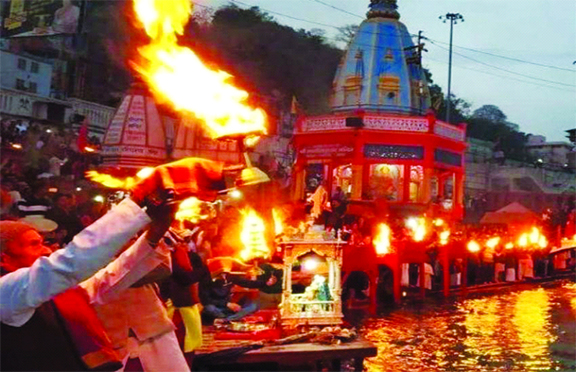
The festival of Ganga Dussehra is celebrated on the tenth day of the Shukla Paksha of Jyeshtha month. This day is a special day for Hindus as well as all mankind. Ganges Dussehra falls in the months of May and June. On Jyeshtha Shukla Paksha Dashami on Monday and Hasta-nakshatra, this date is considered to destroy the sins. Gangavataran took place on Wednesday in Hasta Nakshatra, on this date Ganga Dussehra is also known as Gangavataran. Therefore, this date is more important. On this date, ten sins are destroyed by bathing, charity, and tarpan, hence it is called Dussehra. This is the day when Ganga was brought down to earth to cleanse the cursed souls of her ancestors and destroy sins. Before coming to earth, Goddess Ganga was residing in the kamandal of Lord Brahma.
Bathing in the Ganges has special significance on this day. All the sins of a person are destroyed by bathing the Ganges. The Ganges does not rot even if it is kept year round.
On this day, the fair of Ganga Dussehra is also held at Prayagraj, Allahabad, Garhmukteshwar, Haridwar, Rishikesh and Varanasi, devotees can also enjoy the fair after bathing in the Ganges. The Ganga Dussehra celebrations in Varanasi are legendary. Thousands of devotees bathe in the Ganges on the day of Ganga Dussehra and participate in the Ganga Aarti at Dasaswamedh Ghat in Varanasi and Har Ki Pauri in Haridwar.
Story
In ancient times, a king named Sagar ruled in Ayodhya. He had two queens named Keshini and Sumati. Keshini had a son named Anshuman and Sumati had sixty thousand sons. Once King Sagar performed the Ashwamedha Yagna. A horse was left for the Yajna fulfillment. Indra stole the horse and tied it in Kapil Muni’s ashram to dissolve the yagna. Kapil Muni was doing penance. The king asked his sixty thousand sons to bring a horse. The king’s sons reached the ashram of Kapil Muni, which disrupted the austerity of Kapil Muni and the anger of Kapil Muni was consumed by the fire. Seeing his brothers after getting permission from the father of Anshuman, when Kapil reached Muni’s ashram, Gurud ji told all the accounts of his brothers being consumed. Garuda ji also told Anshuman that if he wants his liberation, then Ganga ji will be brought from heaven to the earth.
After the death of Maharaja Sagara, Anshuman meditated to bring Gangaji to earth, but he failed. After this, his son Dileen also did penance but he also failed.
In the end, Dileep’s son Bhagiratha went to the Gokarna Tirtha to do austerities to bring Gangaji to earth. Pleased with the austerity of Bhagiratha, Brahmaji gave the boon to take Ganga to earth. Now the problem was that after leaving Brahmaji’s corpuscle, who would handle the velocity of Ganga on earth. Brahmaji said that none other than Lord Shankar have this power in the land which can handle the velocity of the Ganges. Therefore, it is appropriate that Lord Shiva be favored for handling the velocity of the Ganges. Bhagirath stood on one thumb and started worshiping Lord Shankar. Pleased with the harsh penance of Bhagiratha, Shivji agreed to handle Ganga in his jatas. In this way, with the inclinations of Lord Shiva, Ganga ji went to the plains by making a chalk in the valleys of the Himalayas. Pleased with this act of Bhagiratha, Brahmaji declared that Gangaji would also be known as Bhagiratha on earth. In this way, mother Ganga came to earth.
Legend Behind The Celebration
The festival Ganga Dussehra is dedicated to the Goddess Ganga and it is believed that Ganga descended to Earth on this day. She descended to accomplish her mission to free the cursed souls of Bhagirath’s ancestors. As per the tradition, before coming to Earth, Goddess Ganga was living in the kamandal of Lord Brahma. When Ganga descended to Earth, she also brought the purity of heaven to Earth.
River Ganga is a gift to humanity due to the great penance of Bhagirath, after which she is also known as Bhagirathi. Bhagirath was the descendant of the Sagara dynasty. He prayed for the Ganga river to descend on the earth and bring life. However, it turned out to be a destructive force. Therefore, Lord Brahma asked Lord Shiva to hold in the locks. As a result, Ganges lost force and became a placid life-living river.
The Ganges is not only the sacred river but also the heart of India. Devotees worship this river for a better fortune. On the day of Ganga Dussehra, thousands of lamps are lit in the flowing river for bringing peace and goodness. Haridwar, Prayag, and Varanasi are the most popular celebration spots of Ganga Dussehra in India. It arises from Gangotri in the snow-clad Himalayas, flows in the hot plains of Uttar Pradesh, Bihar, and meets in the Bay of Bengal. Rivers Ganges meets with Saraswati and Yamuna river in the Allahabad. The confluence of these rivers in Prayag is the holiest spot in India.
Regions Where Ganga Avaratan Is Celebrated
The festival of Ganga Dussehra is observed by Hindus mostly in the states of Uttar Pradesh, Uttarakhand, Bihar, and West Bengal, where the river Ganga flows. Haridwar, Varanasi, Garhmukteshwar, Rishikesh, Allahabad now Prayagraj, and Patna are the major locations of the celebrations. Here the devotees gather at the banks of the Ganges and perform aartis (a religious ritual in which a light lamp is moved clockwise circularly in front of a deity as a part of prayer) to the river.
Invoke the blessings of Goddess Ganga and get rid of all the sins by following special personalized rituals based on your birth chart.
The Significance Of Ganga Avataran Festival
Dussehra signifies ten auspicious Vedic calculations which show Ganga’s power to wash ten sins related to th thoughts, actions, and speech. The ten Vedic calculations include Jyeshtha month, Shukla Paksha, Tenth day, Thursday, Hasta Nakshatra, Siddha Yoga, Gar-Anand Yoga and Moon in Virgo and Sun in Taurus. The offering of prayer allows one to attain salvation. It is a favourable day for purchasing valuable items, new vehicles, or new property. Reciting Ganga Stotra on this day while standing in the Ganges can remove all the sins.
It is believed that taking a dip in the river on this day can bring the devotee to a state of purification and also heal any physical ailments he may have. In Sanskrit, Dasha means ten and Hara means destroy; thus bathing in the river during these ten days is believed to rid the person of the ten sins or, alternatively, the ten lifetimes of sins.
Gain health, wealth, and prosperity by performing personalized Rudrabhishekam Puja on the Ganga Dussehra.





Be the first to comment